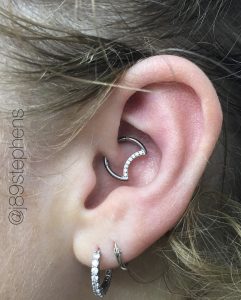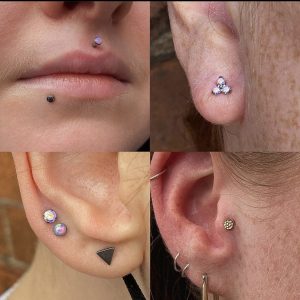When Can I Change My Piercing Jewellery?
One of the most common questions people want an answer to when getting a piercing (apart from how much it will hurt) is when they can safely change the first piece of jewellery to something different of their choosing. This is unsurprising with the growing number of beautifully designed pieces to adorn ears, noses, lips and eyebrows.

Let it heal
The short answer is you need to wait until your piercing is healed. Some jewellery is easier than others and some will require tools which means you need to go see your piercer to have it changed.
New piercings are made with jewellery that is larger or longer to allow for some naturally occurring swelling. Piercings can then take from a couple to six months and even up to a full year to heal completely.
The good news is that you do usually not need to wait a whole 12 months to switch your jewellery. Oral or lip piercings such as the labret, medusa, or philtrum, can be changed fairly quickly, about six to eight weeks after getting them.
Lobe piercings are also realtively quick to heal and you can get some new jewellery after about six weeks. However, piercings on the cartilage part of the ears, such as a helix, a rook, a daith or an industrial piercing, will require a little more patience as piercers suggest waiting three months. Meanwhile, it could take a full six or even eight months.
The thing with cartilage piercings is that they may look healed on the outside before the inner part is done. You want to have had a good three weeks without any crust forming around the piercing. The same goes for navel piercings as well.
What happens if you switch your piercing too soon?

So why shouldn’t you attempt to switch your piercing before you know that it is completely healed? The interior part might still be in the process of healing, and when you pull the jewellery out and put another one in, you risk scratching the partially formed skin.
This results in an irritated piercing, longer healing times, and, in the worst case if any bacteria sneaks its way in there, infection.
Even after you have changed your jewellery for the first time, try not to succumb to the temptation to try out all the cool new looks you have in mind for another year or so.
Very frequent changes can increase the risk of previously mentioned infections, but also allergies. It can also cause bumps and generally uncomfortable swelling.
Don’t be afraid to ask for advice
To support the healing process, always follow the aftercare instructions of your piercer meticulously. If you feel at all uncertain if your piercing is ready to be changed, or if you are unsure of how to do it yourself, book an appointment with your piercer so that they can show and assist you.
